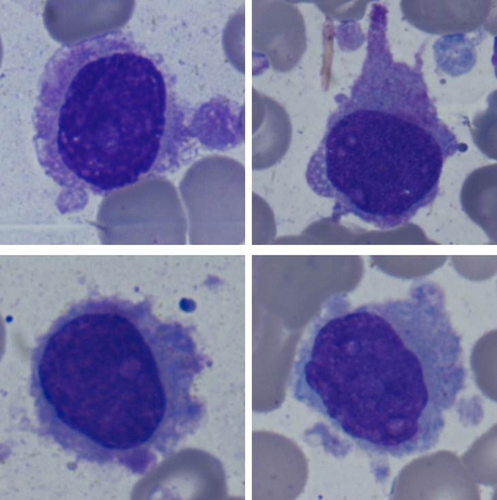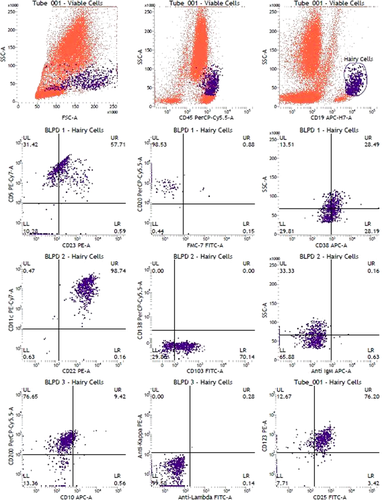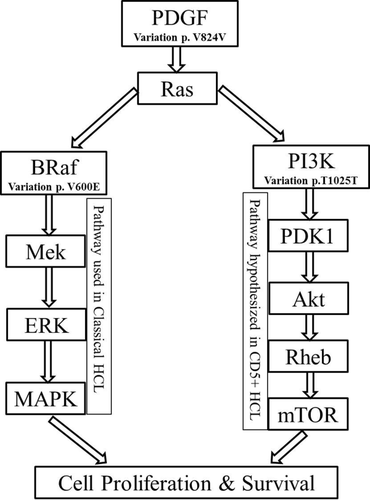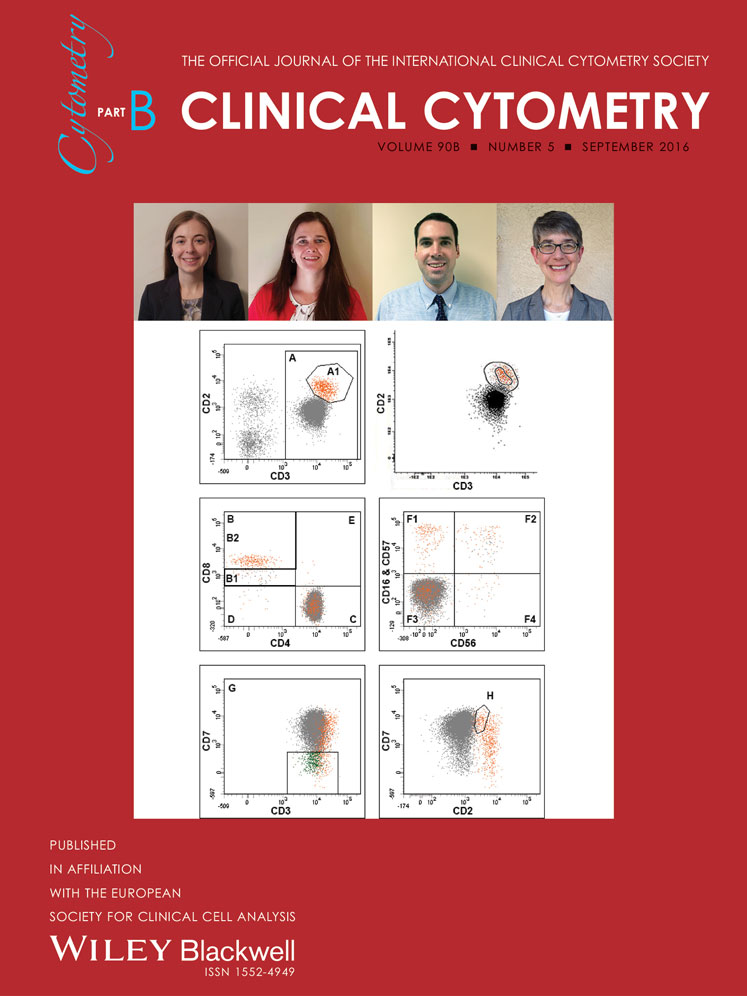CD5 positive hairy cell leukemia: A rare case report with brief review of literature
This article was published online on 30 April 2016. After online publication text corrections were made. This notice is included in the online and print versions to indicate that both have been corrected on 06 July 2016.
Competing Financial Interest: None
Conflict of Interest: None
Abstract
Objective
The aberrant expression of CD5 in both HCL and HCL-v is a very rare event. Although a number of CD5 positive HCL and HCL-v cases have been reported, but these are far and few in between. We aimed to review the reported cases of CD5 positive HCL and its variant.
Method
We hereby report a case of CD5 positive HCL, with variations in PIK3CA and PDGFRA gene, along with a brief review of literature of the cases of CD5 positive HCL and its variant.
Results and Conclusion
The current case was positive for CD103, CD11c, CD25, and CD123 which has led the diagnosis to be of typical HCL. With the extensive literature review we found that only 26 cases of hairy cell leukemia [HCL and HCL-v] bearing CD5 expression have been reported so far. The positivity of CD5 is more common in HCL-v as compared to HCL. Additional prospective studies of CD5+ HCL and its variants are required to show whether they are a clinically significant subgroup of lymphoid malignancies. © 2016 International Clinical Cytometry Society
The morphology and immunophenotype of neoplastic cells in peripheral blood and bone marrow smear are characteristic for the diagnosis of hairy cell leukemia (HCL). The typical markers expressed by leukemic cells of HCL include CD19, CD22, and CD79b, with brighter expression of CD20, along with co-expression of CD103, CD123, and CD11c, which are specific markers for the diagnosis of HCL. In addition, positivity of CD25 and negativity for CD10, CD5, and CD23 are used for diagnosis of HCL. Immunohistochemical analysis showing positivity for Annexin A1 and negativity of CD27 along with CD25, add to the specific diagnosis of HCL and are used for differentiating typical HCL from HCL variant (HCL-v) 1.
Single and combined aberrant variations in the expressions of CD markers have been reported in HCL, which include, but are not limited to, CD103–, CD25–, CD10+, and CD23+ 2.HCL and its variants have been known to be negative for CD5, however, very few reports have been published with its aberrant expression 2. Recently, BRAF V600E mutation has been reported to be associated with the typical form of HCL 3, and its negativity can be used to differentiate it from the variant cases of HCL. However, this has not yet been included in the diagnostic criteria of HCL.
We hereby report a case of CD5 positive HCL, with variations in PIK3CA and PDGFRA gene, along with a brief review of literature of the cases of CD5 positive HCL and its variant.
CASE REPORT
A 46-year-old female presented with the complain of heaviness in abdomen. On abdominal ultrasound she was found to have massive splenomegaly. Complete blood counts showed pancytopenia with a white blood cell count of 1.94 × 103/µL, (neutrophils 41.2%, lymphocytes 53.1%) and platelet count of 72 × 103/µL. The hemoglobin (Hgb) level was 9.0 g/dL. The bone marrow biopsy showed hematopoietic cells of all three lineages with interstitial aggregates and sheets of abnormal lymphoid cells. The bone marrow imprints smears were cellular which showed normal hematopoietic cells along with approximately 21% lymphoid cells including abnormal forms. (Fig. 1) The bone marrow aspiration sample was processed for flow cytometric immunophenotyping. The immunophenotypic evaluation was done using FACSSuite software on six colors FACSVerseTM Flow cytometer (BD Biosciences). The gated lymphoid cells were predominantly B cells (30% of total events) and were gated on CD-19-SSC plot. The gated cells were positive for CD20, CD22 (bright), CD103, CD123, CD25, CD200, CD23 (heterogenous), and negative for FMC7, CD38, CD138, CD10, IgM, Kappa, and Lambda with Matutes score of 1 (All antibodies from BD Biosciences, CA). Interestingly, these cells were also positive for CD5. (Fig. 2) On immunohistochemistry, the bone marrow biopsy showed infiltration by atypical mature B lymphoid cells positive for CD20 and with focal grade I fibrosis. The bone marrow aspiration, biopsy, and immunophenotyping reports were consistent with the diagnosis of HCL. In view of the morphology, clinical findings and CD25 positivity, it was considered as a Classical HCL. The patient was found to be negative for BRAF V600E mutation using next generation sequencing by Ion torrent PGM sequencing machine using the cancer hotspot panel. The interpretation and analysis was done using the torrent browser and additional plugins like variant caller and ion reporter. However, silent point variations in the PIK3CA (Cosmic mutation ID COSM21451) and PDGFRA (Cosmic mutation ID COSM22413) were seen. GRCh37 reference assembly was used for comparison. The patient was managed with Cladribine for seven days (0.9 mg/kg/day). Upon evaluation after three month there was a complete disappearance of all the symptoms of the disease and spleen size become normal. The patient has been disease-free on the latest 6-month follow-up.

Morphology of HCL cells in the present case. Classic Hairy cells with moderate amount of cytoplasm and indistinct cytoplasmic borders with circumferential hairlike projections (Leishman and Giemsa x 1,000). [Color figure can be viewed in the online issue, which is available at wileyonlinelibrary.com.]

Flow cytometric immunophenotyping images. Row-1 (Left to Right): Position of Hairy cells with respect to 1. FSC and SSC, 2. CD19vs SSC 3. CD45vsSSC. Row-2 (Left to Right): Expression of 1. CD5 and CD23, 2. FMC-7 and CD20. 3. CD38. Row-3 (Left to Right): Expression of 1. CD22 and CD11, 2. CD103 and CD138. 3. IgM. Row-4 (Left to Right): Expression of 1. CD10 and CD200, 2. CD25 and CD123. 3. Anti Lambda and Kappa. [Color figure can be viewed in the online issue, which is available at wileyonlinelibrary.com.]
BRIEF REVIEW OF LITERATURE OF CD 5 POSITIVE HCL AND HCL-V CASES
We reviewed only cases of HCL and HCL-v showing CD5 expression. (Table 1) The aberrant expression of CD5 in both HCL and HCL-v is a very rare event 2, 4-11. While going through the literature for CD5 expression in HCL and HCL-v we found that the CD5 positivity rate was higher in HCL-v vis-a-vis HCL [8.8% (12/135) in HCL-v vs.2.3% (14/600) in HCL]. All the 26 cases were positive for CD11c, CD103, CD19, CD20, and CD22. The percent positivity of CD23, Annexin A1, and DBA44 among the total evaluated cases in CD5 + HCL cases were 11%(1/9), 100%(4/4), and 100%(4/4). Interestingly, all the CD5+ HCL-v cases were negative for CD23 and Annexin A1, However, they were positive for DBA44 (2/2). The overall positivity (combining HCL and HCL-v) for CD 23 was 8.3% while it was 100% for Annexin A1 and DBA44. CD123 was positive in more than half (5/9) of the patients with CD5 + HCL while being negative in one of the two cases of CD5+ HCL-v. FMC-7 was positive in all (7/7) the evaluated cases of HCL-v, while it could not be discerned for HCL cases. It was however negative in our case. Data on the BRAF V600E mutation has been scantly reported and in two cases where it was tested, were both CD5 positive HCL-v and were both negative for the mutation. The analysis was not possible for some of the markers namely Anti Lambda, Anti Kappa, TRAP, IgM, CD200, Cyclin D1, CD138, and CD10 due to availability of a very few cases.
| Case No | Diagnosis | CD5 | CD20 | CD22 | CD103 | CD123 | CD11c | CD25 | FMC7 | CD19 | Annexin A1 | CD23 | DBA44 | BRAF V600E | References |
|---|---|---|---|---|---|---|---|---|---|---|---|---|---|---|---|
| 1 | HCL | + | + | + | + | + | + | + | NA | + | NA | - | NA | NA | 2 |
| 2 | HCL | + | + | + | + | + | + | + | NA | + | NA | - | NA | NA | 2 |
| 3 | HCL | + | + | + | + | + | + | + | NA | + | NA | - | NA | NA | 2 |
| 4 | HCL | + | + | + | + | + | + | + | NA | + | NA | - | NA | NA | 2 |
| 5 | HCL-v | + | + | + | + | - | + | - | NA | + | - | - | NA | - | 2 |
| 6 | HCL | + | + | + | + | - | + | + | NA | NA | + | - | + | NA | 4 |
| 7 | HCL | + | + | + | + | - | + | + | NA | NA | + | - | + | NA | 4 |
| 8 | HCL | + | + | + | + | - | + | + | NA | NA | + | - | + | NA | 4 |
| 9 | HCL | + | + | + | + | - | + | + | NA | NA | + | - | + | NA | 4 |
| 10 | HCL | + | + | + | + | - | + | - | NA | NA | - | - | + | NA | 4 |
| 11 | HCL-v | + | + | + | NA | + | + | - | + | + | NA | NA | NA | NA | 5 |
| 12 | HCL | + | + | NA | NA | NA | + | + | NA | + | NA | NA | NA | NA | 6 |
| 13 | HCL-v | + | + | NA | NA | NA | + | NA | NA | NA | NA | - | + | - | 7 |
| 14 | HCL | + | + | NA | NA | NA | NA | NA | NA | + | NA | NA | NA | NA | 8 |
| 15 | HCL | + | + | NA | NA | NA | NA | NA | NA | + | NA | NA | NA | NA | 8 |
| 16 | HCL | + | + | NA | NA | NA | NA | NA | NA | + | NA | NA | NA | NA | 8 |
| 17 | HCL-v | + | + | NA | NA | NA | NA | - | + | + | NA | NA | NA | NA | 9 |
| 18 | HCL-v | + | + | NA | NA | NA | NA | - | + | + | NA | NA | NA | NA | 9 |
| 19 | HCL-v | + | + | NA | NA | NA | NA | - | + | + | NA | NA | NA | NA | 9 |
| 20 | HCL-v | + | + | NA | NA | NA | NA | - | + | + | NA | NA | NA | NA | 9 |
| 21 | HCL-v | + | + | NA | NA | NA | NA | - | + | + | NA | NA | NA | NA | 9 |
| 22 | HCL-v | + | + | NA | NA | NA | NA | - | + | + | NA | NA | NA | NA | 9 |
| 23 | HCL-v | + | NA | NA | NA | NA | NA | NA | NA | NA | NA | NA | NA | NA | 10 |
| 24 | HCL-v | + | NA | NA | NA | NA | NA | NA | NA | NA | NA | NA | NA | NA | 10 |
| 25 | HCL-v | + | NA | NA | NA | NA | NA | NA | NA | NA | NA | NA | NA | NA | 11 |
| 26 | HCL | + | + | + | + | + | + | + | - | + | + | + | NA | - | Present Case |
- +POSITIVE; - NEGATIVE; NA= NOT DONE/NOT REPORTED/NOT CLEARED.
DISCUSSION
Out of the 19 cases of hairy cell leukemia reported by our laboratory over last 5 years, that is, 2010–2014, (data not published), we have seen CD5 positivity for first time in the current case of HCL. The current case was positive for CD103, CD11c, CD25, and CD123 which has led the diagnosis to be of typical HCL. Although rare, in the current review we were able to find a fair number of CD5+ HCL cases. The previous individual studies reported that cases of HCL are generally negative for CD5 5, 12, and there is an extremely rare expression in HCL cases 4, 13. Although the study by Del Giudice et al. reported expression in 9% (1/11 cases) 5, the current review based on evaluating only CD5+ HCL and HCL-v cases suggest that the proportional positivity of CD5 is almost four times high in HCL-v cases as compared to the typical HCL. As the data is too scanty and it was not possible to include the total number of HCL and HCL-v cases from the literature, it was difficult to derive a direct association of CD5 positivity in both HCL and HCL-v. CD11c and CD103 were positive in almost all the evaluated cases (HCL and HCL-v) and CD25 was used to categorize the disease as HCL or its variant. However, exceedingly rare cases of HCL lacking CD103 expression have been reported in the literature 4, 14.
CD23 expression is generally reported to be negative in both HCL 15 and HCL-v 5, 15, 16, however in the present case CD23 was heterogeneous, which correlates with the findings of some previous reports with expression of CD23 [HCL: 6% 4 and 17% 14; HCL-v: 3% 17 HCL (21%), and HCL-v (12%)] 2. However, this is the first case of CD5+ HCL (and also HCL-v) expressing CD23 4-11, Interestingly, CD123 was positive in only half of the CD5+ HCL cases, while it is known to be positive and specific for the HCL with a bright and homogeneous expression 5, 18, 19.
Annexin A1 is known to be positive in typical HCL and negative in HCL-v. In the current case, it is also positive (by IHC), and is in accordance with the previous reports suggesting the specific expression of annexin-A1 in typical HCL (by gene expression profiling) 20. Also further studies based on 500 cases of B cell malignancies confirmed the specificity of Annexin A1 in HCL 21. The DBA44 was not found to be differentiating factor in classifying as HCL or HCL-v; and was positive in all the evaluated cases.
Our results of CD200 positivity are comparable with the earlier reports suggesting CD200 positivity in HCL cases 22 unlike the negative CD200 in most of the HCL-v cases 1. Although, studies indicate that virtually all cases of HCL are associated with a V600E activating mutation in BRAF 2, 3, 7 (one of the RAF gene isoform) and respond to BRAF inhibitor therapy in HCL 23, this has not yet been included in the diagnostic criteria of HCL. In the present case of classical HCL, V600E mutation was absent which is similar to the earlier findings by Liquiang Xi, 2012 wherein a significant group of classical HCLs were negative for this mutation and almost half of these patients were using the IgHV4-34 24. However, we could not analyze IgHV4-34 in the present case. Gain of function mutation in BRAF (BRAFV600E) and mitogen activated protein kinase signaling is considered the key oncogenic pathway in HCL. However, there are multiple reports of BRAF V600E negative HCL cases 13. We hypothesize that in the present case, instead of MAPK/ERK pathway (involved in HCL with V600E), the alternative PI3K/Akt signaling pathway in the downstream of Tyrosine Kinase receptor is being used which involves PDGFRA and PIK3CA. (Fig. 3) Although these two mutations are silent mutations, they could have proliferation advantage during one of the subsequent processes like transcription, splicing, mRNA transport, and translation. Also there is a possibility of mutation/s in BRAF gene outside the regions amplified (Ion AmpliSeq Cancer Hotspot Panel v2, Thermo Fisher Scientific). These silent mutations have also been seen in other hematological malignancies like PIK3CA in T cell acute lymphoblastic leukemia 25 and PDGFRA in myelodysplaic syndromes 26. A recent publication by a German group has found that CDKN1B is the second most common mutation in HCL. This gene was not part of the gene panel that we studied. The mutation in EZH2 gene which was reported by this group, was found to be absent in our case 27.

Signaling pathway hypothesized in the present case of CD5+ HCL.
In the present case, patient showed complete response to chemotherapy which is similar to the earlier reports for such a therapy in classical HCL cases 28, 29. An attempt was made to look for the prognosis of HCL and HCL-v cases expressing CD5. However, these have not been described specifically, except in one report 11 of partial response with Cladribine. Sainiti et al. reported poor prognosis (Median Survival 4 years) in 15 out of 17 total evaluated cases of HCL-v, including six cases expressing CD5 9. Summary and Conclusions: The CD5 positive HCL is a rare entity. The positivity of CD5 is more common in HCL-v as compared to HCL. Additional prospective studies of CD5+ HCL and its variants are required to show whether they are a clinically significant subgroup of lymphoid malignancies.
ACKNOWLEDGMENT
We would like to thank the team members of Molecular genetics and immunology laboratory of Medanta-The Medicity for their support.




